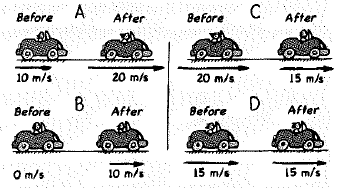
Concept explainers
Below we see before and after snapshots of a car’s velocity. The time interval between before and after for each is the same.

a. Rank the cars in terms of the change in velocity, from most positive to most negative. (Negative numbers rank lower than positive ones, and remember, tie scores can be part of your ranking.)
b. Rank them in terms of acceleration, from greatest to least.
(a)
The rank of the cars in terms of the change in velocity, from most positive to most negative.
Answer to Problem 21A
The rank of the cars in terms of the change in velocity, from most positive to most negative is
Explanation of Solution
Formula used:
The expression for the change in velocity as follows:
Here,
Calculation:
The change in velocity for case A as follows:
The change in velocity for case B as follows:
The change in velocity for case C as follows:
The change in velocity for case D as follows:
By comparing the values, the change in velocity is
Conclusion:
Thus, the rank of the cars in terms of the change in velocity, from most positive to most negative is
(b)
The rank of the cars in terms of acceleration from greatest to least.
Answer to Problem 21A
The rank of the cars in terms of acceleration from greatest to least is
Explanation of Solution
Formula used:
The expression for the change in velocity as follows:
Here,
Calculation:
Acceleration is the variation in velocity during a given period of time. That is acceleration is directly proportional to the change in velocity.
Refer part (a).
The change in velocity for case A is
The change in velocity for case B is
The change in velocity for case C is
The change in velocity for case D is
By comparing the values, the change in velocity is
Hence, the rank of the cars in terms of acceleration from greatest to least is
Conclusion:
Thus, the rank of the cars in terms of acceleration from greatest to least is
Chapter 4 Solutions
EP CONCEPTUAL PHYSICS-ITEXT ACCESS
Additional Science Textbook Solutions
Microbiology: An Introduction
Microbiology with Diseases by Body System (5th Edition)
Genetic Analysis: An Integrated Approach (3rd Edition)
Organic Chemistry (8th Edition)
Microbiology: An Introduction
Chemistry: An Introduction to General, Organic, and Biological Chemistry (13th Edition)
- Find the ratio of the diameter of silver to iron wire, if they have the same resistance per unit length (as they might in household wiring). d. Ag dFe = 2.47 ×arrow_forwardFind the ratio of the diameter of silver to iron wire, if they have the same resistance per unit length (as they might in household wiring). d Ag = 2.51 dFe ×arrow_forwardShow that the units 1 v2/Q = 1 W, as implied by the equation P = V²/R. Starting with the equation P = V²/R, we can get an expression for a watt in terms of voltage and resistance. The units for voltage, V, are equivalent to [? v2 v2 A, are equivalent to J/C ✓ X . Therefore, 1 = 1 = 1 A V1 J/s Ω V-A X = 1 W. . The units for resistance, Q, are equivalent to ? The units for current,arrow_forward
 College PhysicsPhysicsISBN:9781305952300Author:Raymond A. Serway, Chris VuillePublisher:Cengage Learning
College PhysicsPhysicsISBN:9781305952300Author:Raymond A. Serway, Chris VuillePublisher:Cengage Learning University Physics (14th Edition)PhysicsISBN:9780133969290Author:Hugh D. Young, Roger A. FreedmanPublisher:PEARSON
University Physics (14th Edition)PhysicsISBN:9780133969290Author:Hugh D. Young, Roger A. FreedmanPublisher:PEARSON Introduction To Quantum MechanicsPhysicsISBN:9781107189638Author:Griffiths, David J., Schroeter, Darrell F.Publisher:Cambridge University Press
Introduction To Quantum MechanicsPhysicsISBN:9781107189638Author:Griffiths, David J., Schroeter, Darrell F.Publisher:Cambridge University Press Physics for Scientists and EngineersPhysicsISBN:9781337553278Author:Raymond A. Serway, John W. JewettPublisher:Cengage Learning
Physics for Scientists and EngineersPhysicsISBN:9781337553278Author:Raymond A. Serway, John W. JewettPublisher:Cengage Learning Lecture- Tutorials for Introductory AstronomyPhysicsISBN:9780321820464Author:Edward E. Prather, Tim P. Slater, Jeff P. Adams, Gina BrissendenPublisher:Addison-Wesley
Lecture- Tutorials for Introductory AstronomyPhysicsISBN:9780321820464Author:Edward E. Prather, Tim P. Slater, Jeff P. Adams, Gina BrissendenPublisher:Addison-Wesley College Physics: A Strategic Approach (4th Editio...PhysicsISBN:9780134609034Author:Randall D. Knight (Professor Emeritus), Brian Jones, Stuart FieldPublisher:PEARSON
College Physics: A Strategic Approach (4th Editio...PhysicsISBN:9780134609034Author:Randall D. Knight (Professor Emeritus), Brian Jones, Stuart FieldPublisher:PEARSON





